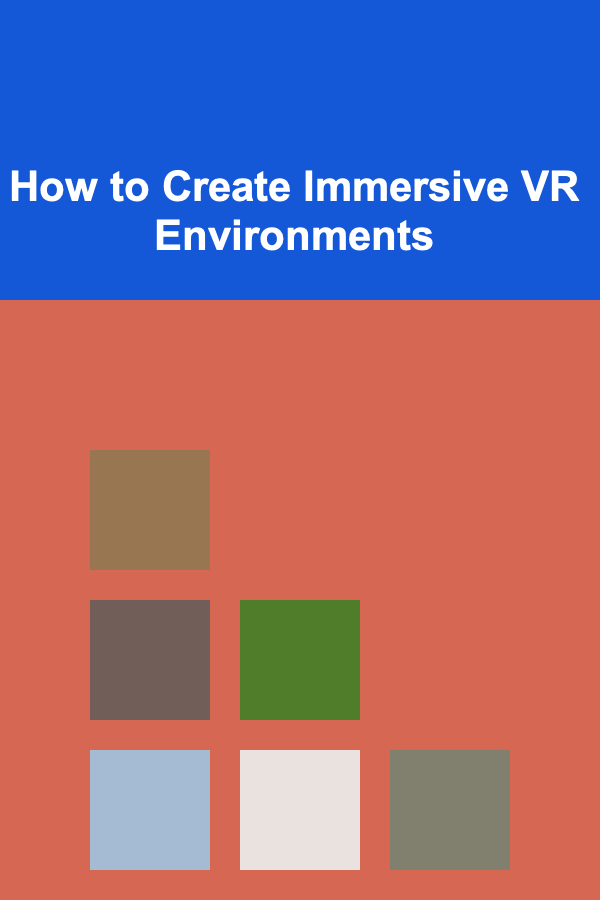
How to Create Immersive VR Environments
ebook include PDF & Audio bundle (Micro Guide)
$12.99$5.99
Limited Time Offer! Order within the next:

Virtual Reality (VR) technology has significantly transformed various industries, from gaming to education, healthcare, architecture, and more. One of the most crucial elements that make VR experiences impactful is the environment in which users interact. An immersive VR environment can transport users to new worlds, enhancing engagement and creating unforgettable experiences.
Creating immersive VR environments requires a blend of technological expertise, creative design, and an understanding of how users interact with their surroundings in a virtual space. In this article, we will explore the essential components and steps involved in designing and developing immersive VR environments, covering the principles of immersion, tools and technologies, user interaction, and design best practices.
Understanding Immersion in VR
Immersion in VR refers to the feeling of being physically present in a virtual world. It is the sensation that the user's environment is entirely virtual and that they can interact with it in real-time. Immersion is a critical factor in ensuring that a VR experience feels believable, engaging, and convincing. The two main components that contribute to immersion in VR are:
1. Visual Immersion
Visual immersion is the most obvious aspect of any VR environment. High-quality graphics, realistic textures, and effective lighting are essential to create a convincing virtual space. This includes:
- High-Resolution Textures: Using textures that appear realistic up close is crucial. For instance, the texture of a wooden table, the roughness of a stone wall, or the reflections in a water surface can significantly impact the realism of a VR environment.
- Lighting and Shadows: Proper lighting is a key component in enhancing immersion. It adds depth and dimension to the virtual world, making it feel more natural. Dynamic lighting, where the environment changes according to the time of day or interactions within the world, can also make the experience more lifelike.
- Field of View (FoV): The user's field of view in VR should mimic the natural human vision to enhance immersion. Typically, an FoV of 100-110 degrees is standard, though higher values can help improve the sense of being "there."
2. Auditory Immersion
Sound is just as critical as visuals in creating an immersive VR environment. The auditory cues help ground the user in the virtual space, making it feel more real. This involves:
- 3D Spatial Audio: Sounds should come from specific directions and distances relative to the user's position. If someone is walking behind you in a virtual environment, you should hear their footsteps from the rear.
- Environmental Sounds: Ambient sounds, such as wind blowing, birds chirping, or distant traffic, can add a layer of depth to the environment. These sounds should dynamically change as the user moves through different spaces.
- Interactive Sounds: Sound effects that correspond with the user's actions (e.g., opening a door, picking up an object, or triggering a mechanism) can enhance the feeling of interaction and engagement.
3. Haptic Feedback
Haptic feedback involves tactile sensations that users feel through their VR controllers or haptic gloves. When properly integrated, haptic feedback can replicate the sensation of touching objects in the virtual environment, such as feeling the vibration of a phone or the resistance of a door opening. This contributes to the realism and engagement of the experience.
4. Motion Tracking and User Input
The more precisely VR can track the user's movements and translate them into the virtual world, the more immersive the environment will feel. This includes:
- Head Tracking: Users' head movements should be tracked accurately to reflect the changes in the virtual environment. This is typically achieved through sensors in VR headsets.
- Hand Tracking: The movement of the user's hands and fingers can be tracked to interact with objects in the environment. Advanced systems may even capture gestures and body movements for more nuanced control.
- Full-body Tracking: For highly immersive VR applications, full-body tracking can be used to map the user's entire body into the virtual space, allowing for more lifelike interaction with objects and characters.
Tools and Technologies for Creating VR Environments
Designing a high-quality, immersive VR environment requires using specialized software tools and hardware. These technologies facilitate the creation of realistic, engaging virtual worlds. Let's break down the essential tools:
1. Game Engines
Game engines are the backbone of most VR environments. They are powerful software platforms that allow developers to create, simulate, and render 3D environments. Some of the most commonly used game engines for VR development include:
- Unity: Unity is a versatile and widely-used game engine that offers extensive support for VR development. Its flexible architecture allows developers to create everything from simple VR experiences to complex, interactive virtual worlds. Unity's integration with VR SDKs like Oculus, HTC Vive, and others makes it an excellent choice for VR creators.
- Unreal Engine: Known for its high-quality graphics and realistic rendering, Unreal Engine is another popular choice for VR development. It uses a node-based scripting system called Blueprints, which makes it easier for non-programmers to create VR experiences. Unreal Engine also supports a range of VR devices, ensuring compatibility across different headsets.
2. VR SDKs (Software Development Kits)
To build VR experiences, developers need VR SDKs that provide the necessary tools for interacting with hardware and implementing immersive interactions. These SDKs typically support a range of VR headsets and controllers. Some notable SDKs include:
- Oculus SDK: Oculus provides an SDK that offers a variety of tools for developing VR applications compatible with Oculus Rift, Quest, and other Oculus headsets. It includes features like hand tracking, immersive input, and spatial audio.
- SteamVR SDK: SteamVR is a popular platform for HTC Vive, Valve Index, and other VR hardware. The SteamVR SDK provides libraries and tools to enable VR interactions, motion tracking, and device compatibility.
- Microsoft Mixed Reality Toolkit (MRTK): This SDK is tailored for creating cross-platform applications that work on both VR and augmented reality (AR) devices. It's a great option for building immersive experiences for HoloLens, Windows MR, and other platforms.
3. 3D Modeling and Animation Software
To design realistic virtual environments, 3D models of objects, environments, and characters are required. The following tools are commonly used in VR design:
- Blender: Blender is a free and open-source 3D modeling software that is widely used for creating 3D assets, animation, and rendering. Its compatibility with game engines like Unity and Unreal Engine makes it a popular choice for VR developers.
- Autodesk Maya: Maya is a professional-grade 3D modeling and animation tool often used for creating high-quality assets for VR experiences. It's particularly strong in character modeling and animation, making it suitable for more complex VR worlds.
- Cinema 4D: Cinema 4D is another powerful 3D software known for its ease of use and integration with other software tools like After Effects. It's often used in the VR industry for creating visually stunning environments.
4. Audio Software
Creating an immersive auditory experience is crucial for realism. Software tools for audio design and spatial sound implementation include:
- Audacity: A free, open-source audio editing tool used to create and manipulate sound effects for VR experiences.
- Reaper: A powerful audio production tool for recording, editing, and mixing audio. Reaper is particularly useful for integrating 3D spatial audio.
- FMOD: FMOD is a professional audio middleware tool used to implement complex sound environments in games and VR applications. It provides support for 3D sound, dynamic audio generation, and real-time audio interaction.
Designing Immersive VR Environments
The design process for creating an immersive VR environment is both creative and technical. Below are the main steps involved in designing an engaging and believable VR world.
1. Defining the Purpose of the Environment
Before diving into the technical details, it is essential to define the purpose of the VR environment. Is it for entertainment, education, training, or a social experience? Understanding the environment's goal will help inform design decisions, such as layout, interaction mechanics, and user experience.
For instance, a VR game might prioritize action-packed, dynamic environments with interactive elements, while a VR training simulation may require a more realistic and immersive environment that mimics real-world settings.
2. Creating a Visual Style
The visual style of a VR environment is essential to its appeal. Will the environment be realistic, fantastical, or abstract? The design choices you make in terms of textures, colors, lighting, and architectural elements will set the tone and aesthetic of the experience.
Realistic VR environments require careful attention to detail, including textures, materials, and lighting to ensure the world feels convincing. For example, accurate physics and realistic object interactions are important for creating a sense of realism. On the other hand, stylized or abstract environments can use creative visual elements to evoke specific moods or narratives.
3. Building Interactive Elements
User interaction is one of the defining aspects of VR. A good VR environment should offer a range of interactive elements that respond to the user's actions. These interactions could include:
- Object Manipulation: Users should be able to grab, throw, or use objects in the environment. VR controllers or hand tracking allow for intuitive object manipulation.
- Navigation: Users should be able to move through the environment in a way that feels natural, whether it's by walking, teleporting, or using a joystick. It's crucial to minimize motion sickness during movement, which can be achieved by offering smooth, gradual transitions.
- Environmental Triggers: Interactive elements like buttons, levers, or switches allow users to trigger changes within the environment, such as opening doors, changing lighting, or triggering events.
4. Optimizing for Performance
Performance is key to an immersive VR experience. The environment should run smoothly without lag or frame rate drops, as these can break immersion and cause motion sickness. The following strategies can help optimize VR environments:
- Level of Detail (LOD): Use lower-resolution models for distant objects to reduce the load on the system.
- Occlusion Culling: This technique ensures that only visible objects are rendered, improving performance by not rendering objects hidden behind others.
- Efficient Asset Management: Optimize 3D models, textures, and audio files to reduce their impact on performance.
5. User Testing and Feedback
Once the environment is designed, it's important to conduct user testing to gather feedback on immersion, usability, and overall experience. Watch how users interact with the environment, listen to their feedback, and make adjustments accordingly.
Conclusion
Creating immersive VR environments is a complex and multidisciplinary task that involves blending art, technology, and psychology. The goal is to create a world that feels believable, interactive, and engaging, where users can lose themselves in the experience. By focusing on visual realism, spatial audio, intuitive interactions, and user comfort, developers can create VR environments that offer truly immersive and unforgettable experiences. With the right tools and design principles, it's possible to transport users to entirely new worlds, changing the way they perceive reality.

How to Declutter Your Home Before Moving
Read More
How to Ensure Your Rental Property is Up to Code
Read More
How to Offer Early Bird Discounts Through Event Registration: A Comprehensive Guide
Read More
How to Soundproof a Kitchen to Reduce Noise from Appliances
Read More
How to Design a Blog Planner That Actually Works for You
Read More
10 Tips for Content Strategists to Improve SEO
Read MoreOther Products

How to Declutter Your Home Before Moving
Read More
How to Ensure Your Rental Property is Up to Code
Read More
How to Offer Early Bird Discounts Through Event Registration: A Comprehensive Guide
Read More
How to Soundproof a Kitchen to Reduce Noise from Appliances
Read More
How to Design a Blog Planner That Actually Works for You
Read More